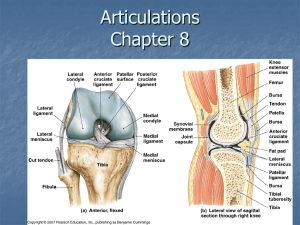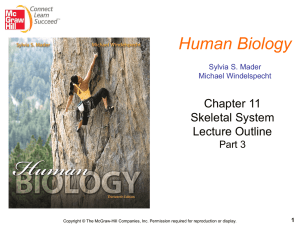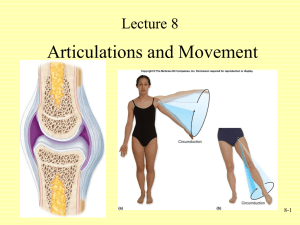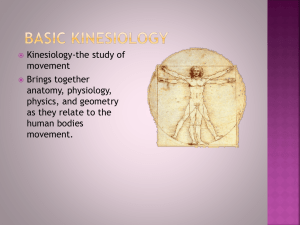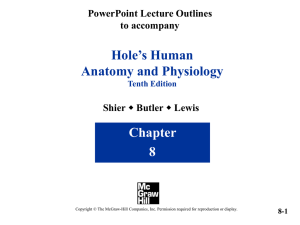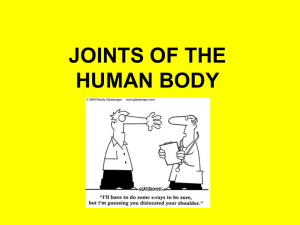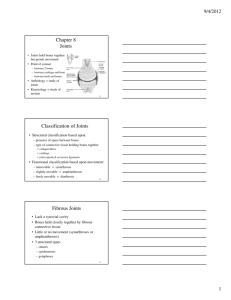Chapter 9 Outline - North Mac Schools
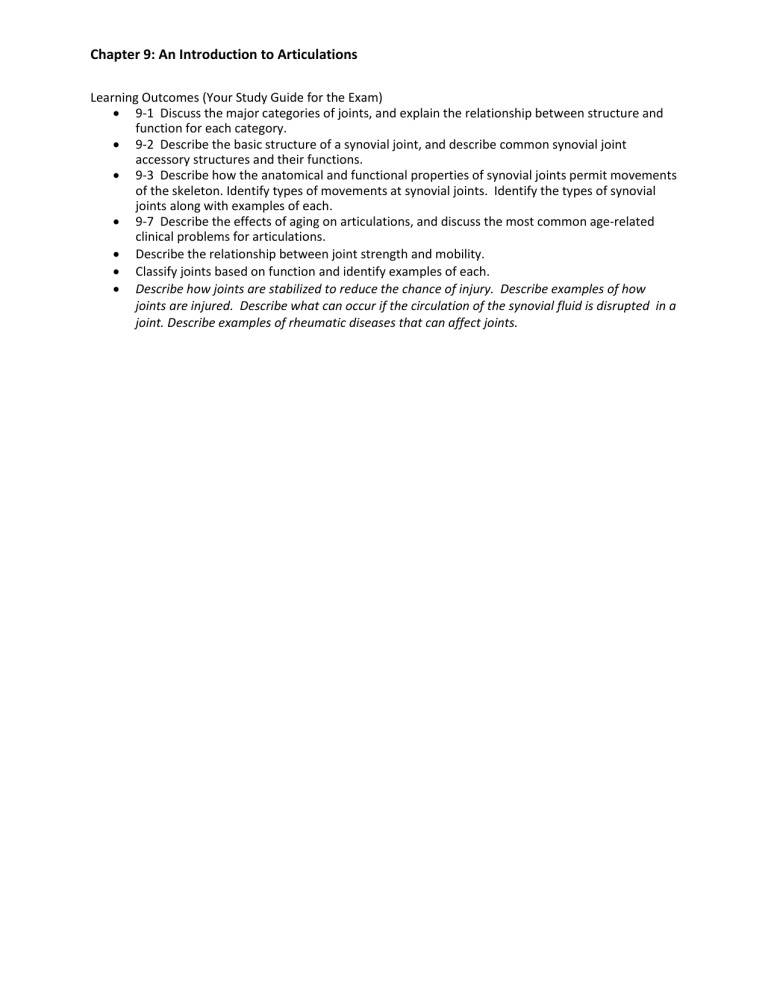
Chapter 9: An Introduction to Articulations
Learning Outcomes (Your Study Guide for the Exam)
9-1 Discuss the major categories of joints, and explain the relationship between structure and function for each category.
9-2 Describe the basic structure of a synovial joint, and describe common synovial joint accessory structures and their functions.
9-3 Describe how the anatomical and functional properties of synovial joints permit movements of the skeleton. Identify types of movements at synovial joints. Identify the types of synovial joints along with examples of each.
9-7 Describe the effects of aging on articulations, and discuss the most common age-related clinical problems for articulations.
Describe the relationship between joint strength and mobility.
Classify joints based on function and identify examples of each.
Describe how joints are stabilized to reduce the chance of injury. Describe examples of how
joints are injured. Describe what can occur if the circulation of the synovial fluid is disrupted in a
joint. Describe examples of rheumatic diseases that can affect joints.
Chapter 9: An Introduction to Articulations
I.
II.
An Introduction to Articulations
A.
Body movement occurs at joints (articulations) where two bones connect
B.
Joint Structure:
1.
Determines direction/distance of movement(range of motion or ROM)
2.
Joint strength decreases as mobility increases a.
Example: b.
Shoulder joint permits greatest range of motion of any joint = most frequently dislocated joint
9-1 Classification of Joints
A.
Two Methods of Classification
1.
Functional classification: based on ROM a.
Synarthrosis i.
immovable joint ii.
can be fibrous or cartilaginous iii.
over time two bones may fuse iv.
occurs where movement between bones must be prevented b.
Amphiarthrosis i.
slightly movable joint, making it stronger than diarthrosis ii.
can be fibrous or cartilaginous iii.
articulating bones connected by collagen fibers or cartilage c.
Diarthrosis i.
freely movable joint ii.
further divided according to nature of movement permitted iii.
always synovial
2.
Structural classification: relies on anatomical organization of the joint a.
Bony b.
Fibrous c.
Cartilaginous d.
Synovial
Chapter 9: An Introduction to Articulations
Joint Classification
Functional Category
Synarthrosis
Type
Suture
Description/Examples
Located between bones of skull
Edges of bones are bound together at suture by dense fibrous connective tissue
Binds teeth to bony sockets in maxilla/mandible Gomphosis
Synchondrosis Rigid, cartilaginous bridge between two articulating bones
Examples: epiphyseal cartilage and connection between first pair of ribs and sternum
Synotosis Created when two bones fuse and boundary between them disappears
Example: coronal suture of frontal bone and epiphyseal lines of mature long bones
Amphiarthrosis Syndesmosis
Diarthrosis
Symphysis
Synovial
Bones connected by ligament
Example: distal articulation between tibia and fibula
Articulating bones separated by wedge or pad of fibrocartilage
Example: articulation between two pubic bones
Permit wider range of motion than other joints
Typically located at ends of long bones
Examples: elbow, shoulder, hip, knee, ankle and wrist joints
III.
9-2 Synovial Joints (Diarthroses)
A.
Also called movable joints
B.
Found at the ends of long bones
C.
Surrounded by two-layered articular/joint capsule
1.
Joint capsule lined with synovial membrane (inner layer)
2.
Joint capsule contains fibrous capsule (outer layer)
D.
Structure of Synovial Joints
1.
Articular cartilage a.
Covers and pads articulating surfaces b.
Prevents bones from touching c.
Lubricated by synovial fluid
2.
Synovial fluid provides a.
Lubrication, minimizes friction b.
Nutrient distribution i.
Fluid circulates continuously to provide nutrients and remove waste for chondrocytes ii.
Circulates whenever joint moves c.
Shock absorption i.
When pressure increases, shock is lessened as synovial fluid spreads across articular surface outward to the capsule
3.
Meniscus a.
Made up of fibrocartilage b.
Cushions joint
4.
Fat pads: protects articular cartilage
Chapter 9: An Introduction to Articulations
5.
Ligaments a.
Attach bone to bone b.
Support, strengthen and reinforce joints
6.
Tendons a.
Attach muscle to bone b.
Helps support joint
7.
Bursae a.
Small pouches/pockets filled with synovial fluid b.
Cushions where tendons/ligaments rub c.
Bursitis i.
when bursae become inflamed whenever tendon/ligaments move ii.
can be associated with repetitive motion or pressure to joint area
IV.
9-2 Synovial Joints and Injury
A.
Preventing injury = limiting range of motion/stabilizing joint
B.
If movement occurs beyond ROM = damage
C.
Factors responsible for limiting ROM:
1.
Collagen fibers (joint capsule, ligaments)
2.
Shape of articulating surfaces and menisci
3.
Other bones, muscles, or fat pads
4.
Tendons of articulating bones
D.
Types of Injuries
1.
Sprain a.
ligaments with some torn collagen fibers b.
Ligament as a whole survives and joint is not damaged
2.
Dislocation (luxation) a.
Articulating surfaces forced out of position b.
Damages articular cartilage, ligaments, joint capsule
3.
Subluxation: partial dislocation
Chapter 9: An Introduction to Articulations
Possible Movement Types of Movements/Description
1.
2.
Gliding
V.
Angular
9-3 Types of Movement at Synovial Joints
Two opposing surfaces slide past one another
Movement can occur in any direction
Movement is slight
Flexion: movement in anterior-posterior plane that decrease angle between articulating bones
Extension: movement in anterior-posterior plane that increases angle between articulating bones
Hyperextension: extension past anatomical position
Example
Occurs between:
surfaces of articulating carpal/tarsal bones
clavicles and sternum
Bringing head to chest
Bending town to touch your toes
Reversing flexion movement
In anatomical position, all joints are at full extension
Looking up at the ceiling hyperextends neck
Prevented in some joints
Swinging upper limb to the side
3.
Rotation
Special Movements
Abduction: movement away from longitudinal axis of body in frontal plane (appendicular skeleton only)
Adduction: movement toward longitudinal axis of body in frontal plane (appendicular skeleton only)
Circumduction
Left/right rotation
Lateral rotation: Anterior surface of limb turns away from long axis of trunk
Pronation
Supination
Inversion
Eversion
Dorsiflexion
Bringing upper limb from out to the side back to anatomical position
Moving arm in a loop
Hand moves in circle, arm does not rotate
Movement of head right or left
Rotating arm so palm faces up and arm is away from trunk
Turns wrist and hand from palm facing front to palm facing back
Turns wrist and hand from palm facing back to palm facing front
Twisting movement of foot that turns sole inward
Twisting movement of foot that turns sole outward
Flexion at ankle joint and elevation of sole
(when you dig in your heel)
Extends ankle joint and elevates heel (when Plantar flexion
Opposition
Reposition
Protraction: Moving a body part anteriorly in the horizontal plane
Retraction: reverses protraction you stand on tiptoes)
Movement of thumb toward surface of palm/pads of fingers
Returns fingers and thumb from opposition
Jaw protracts when you grab upper lip with lower teeth
Elevation: structure moves superior
Returning jaw to normal position from protracted position
Closing your mouth elevates mandible
Shrugging shoulders
Depression: structure moves inferior Opening mouth depresses mandible
Lateral flexion: When vertebral column bends to side Bending head toward shoulder
Chapter 9: An Introduction to Articulations
VI.
Classification of Synovial Joints by Shape
Type
Gliding Joint
Description
Aka plane joints
Have flattened or slightly curved faces
Amount of movement is slight
Hinge Joint
Pivot Joint
Permit angular movement in single plane, like opening/closing of door
Permit only rotation
Example
Joint between scapula and clavicle (acromioclavicular)
Elbow, knee, ankle
Condylar Joint
Saddle Joint
Oval articular face nestle within depression on opposing surface
All angular movements occur
Fit together like a rider in a saddle
Permits angular movement, prevents rotation
Ball-and-socket Joint Round head of one bone rests within cup-shaped depression of another
VII.
9-7 Effects of Aging on Articulations
Joint between atlas and axis
(atlanto-axial)
Joint between radius and carpals (radiocarpal)
Joint between first metacarpal and carpal (carpometacarpal)
Should and hip joints
A.
Degenerative Changes
1.
Rheumatism a.
A pain and stiffness of skeletal and muscular systems b.
Several major forms
2.
Arthritis a.
All forms of rheumatism that damage articular cartilages of synovial joints b.
Damage results from: i.
Infection ii.
Injury to joint iii.
Metabolic problems iv.
Severe physical stresses
Chapter 9: An Introduction to Articulations
Rheumatic diseases affecting Synovial Joints
Form Description
Osteoarthritis Caused by:
• wear & tear of joint surfaces
• Genetic factors affecting collagen formation
Generally affects people 60 or older
Rheumatoid arthritis Inflammatory condition
Caused by:
• Infection
• Allergy
• Autoimmune disease: body attacks own tissues
Gouty arthritis Buildup of uric acid crystals in synovial fluid interferes w/ joint movement
Caused by:
• Gout
• Calcification of joints in people over 85

